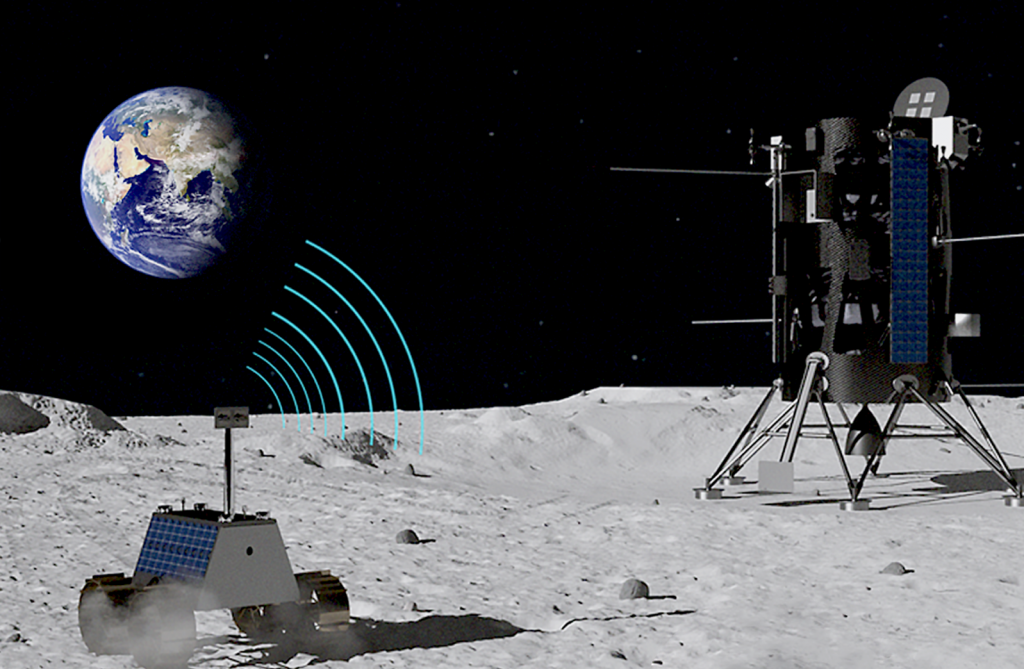As part of the Artemis program, NASA aims to establish sustainable exploration on the Moon by the end of the decade. To support that vision, our team in space tech continues to initiate public-private partnerships to develop the infrastructure, such as communications and power, needed for a long-term lunar presence.
NASA’s current lunar concept calls for an Artemis Base Camp on the South Pole, built with commercial and international partners. A lunar terrain vehicle (LTV), a mobile home and a lunar cabin on the surface would provide astronauts the ability to explore more of the lunar surface and stay on the Moon for longer periods of time than ever before.
Just like here on Earth, space cars and homes will require power and communications capabilities. Unlike what’s often depicted in sci-fi films though, there are many challenges to communicating in space, such as delays and bandwidth, among others. Technology advancements could make lunar calling plans much easier in the near future.
Whether our astronauts are traveling to the surface aboard a modern human landing system, exploring during a moonwalk, roving around in the LTV, working in a mobile home on the Moon, or even aboard the Gateway in lunar orbit, communication is critical between Earth and among crew in all these activities planned for the Artemis program.
Inspired by Earth-based communications technologies, Nokia Bell Labs recently proposed to NASA the first cellular communications network on the Moon. Their idea is to deploy an end-to-end communication system on the lunar surface using LTE technology. The initial proposed Nokia network would be used for proximity communications on the lunar surface, providing wireless network coverage around the landing module. In the future, this technology and its evolution also could be used for providing communications to and from a spacecraft orbiting the Moon.
During our evaluation of this proposal, we found it’s a promising technology that could meet needs for the agency as well as other potential lunar customers. Nokia would use a commercial Moon delivery service provider, an initiative created by NASA, to deliver hardware to the lunar surface in late 2022.
That proposal was one of 15 “tipping point” technologies we recently selected and NASA’s Space Technology Mission Directorate will invest in to advance commercial systems supporting human exploration of the Moon and Mars.
Through our Lunar Surface Innovation Initiative we are targeting communications as one of its top areas to advance technology readiness levels for deep space. Another surface innovation we want to advance is power generation. With a constant energy source from the Sun for solar power or the potential to extract and convert resources on the Moon to expand exploration capabilities, NASA is considering many options to power a broad range of systems in orbit and on the surface of the Moon. In response to the same tipping point solicitation, we selected several proposals related to power generation and energy storage.
Precision Combustion aims to mature a deep space fuel product that could be used for power generation and energy storage. Using a modern solid oxide fuel cell stack developed by the company, lunar customers like NASA would be able to generate power directly from propellants (methane/liquid oxygen) and in-situ resources. The proposal received high marks from NASA because of the technology readiness level, maturation plan, and fact that it can be used anywhere on the Moon.
Long-term, the use of space-based resources is key to reducing the cost of deep space travel and reducing dependence on supply shipments from Earth. Precision Combustion believes its approach could result in as much as 10 times the reduction in the cost of equivalent power generation.
Both of these technologies will receive milestone-based investments from the agency, with Nokia receiving an award of about $14 million, and Precision Combustion receiving $2.4 million.
We reviewed dozens of proposals and found these two responses plus 13 others to have some of the highest potential to provide substantial benefit to government and other customers if they reach the market.
The expected combined award value for our most recent tipping point investments is more than $370 million. We look forward to partnering with Nokia and Precision Combustion as well as Eta Space, Lockheed Martin, SpaceX, United Launch Alliance, Alpha Space, Astrobotic Technology, Intuitive Machines, Masten Space Systems (on two proposals), pH matter, Sierra Nevada Corporation, Maxar Technologies, and Teledyne Energy Systems. The firm-fixed price contracts with each company could last up to five years, and the goal is to help the technology reach a successful in-space demonstration without further government investments before ultimately becoming commercially available.
This decade, the Artemis program will lay the foundation for a sustained long-term presence on the lunar surface. As humanity’s lunar presence and capabilities grow, we look forward to using our knowledge gained from activities on the Moon to prepare for our next giant leap – human exploration of Mars – as early as the 2030s.
– Jim Reuter, associate administrator for NASA’s Space Technology Mission Directorate

